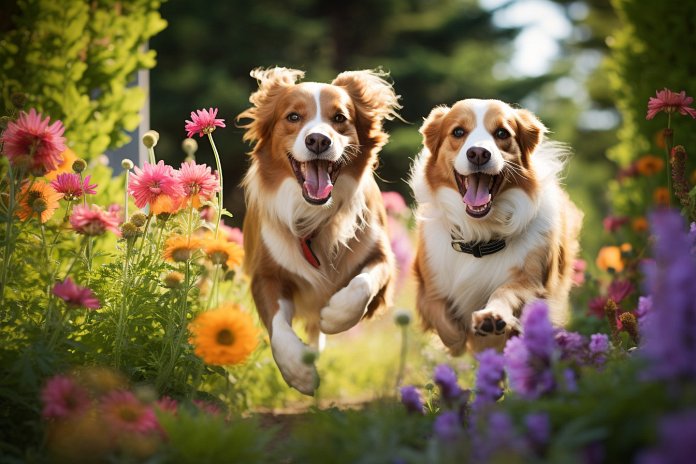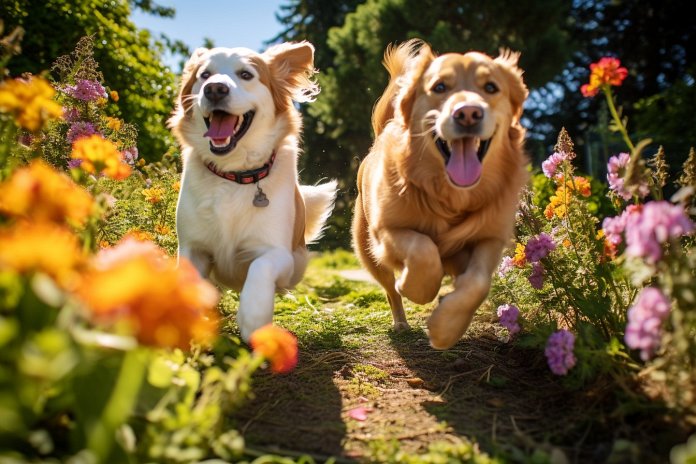
Remember the story of Lady and the Tramp? In the 1955 Walt Disney movie, Lady and Tramp, two dogs from different backgrounds, fell in love and had adventures together. Their courtship and affectionate gestures have been admired for generations. But Lady and Tramp are not the only dogs to fall in love. Many dogs show love and form strong bonds with the people and animals they live with. They display signs of loyalty, bonding, and love through their behavior.
Signs a Dog Is in Love
Dogs may not be able to speak, but they have various ways of communicating their emotions and desires. One way to tell if your dog is in love is by observing their tail. A wagging tail is a sign of excitement and love, while a tucked tail can indicate fear or submission.
Dogs also show their love in ways similar to humans. They may stay close to the person they love and nuzzle up to them. Dogs who are attached to someone spend time together during their daily routines of walking, playing, sleeping, and eating.
Enthusiasm is another sign of love in dogs. They may get excited and start jumping around or even jump on their loved ones. Dogs have a strong sense of smell, so they actively explore the scent of the person they love, often sniffing their behind area. Their anticipation and joy are evident in their wagging tails. Dogs also groom each other and their humans by licking, which we often refer to as “kisses” when they lick us on the mouth.
The demonstration of love is evident in the attentiveness, loyalty, and constant companionship that dogs show when they love someone. They may follow their loved ones around, seeking constant closeness and even rubbing up against them. Dogs also engage in playful behavior, such as gleeful romping, chasing, and running together. They enjoy huddling up and sleeping next to each other. Interestingly, another sign of affection is when a dog openly pees in the area of their loved one, marking it as theirs.
Body Language
Signs that a dog is full of love include jumping up, wagging their tail, sniffing, and licking. Other signs of love to watch for include being attentive to the person they love, following them around, engaging in playful activities, staying with them when they’re sick, snuggling up and sleeping next to each other, and urinating in their presence.
The History of Dogs Showing Love
Dogs are naturally social creatures, and their social behavior can be traced back to their wild ancestors, the wolf pack. Over time, dogs have become more domesticated and bred for different roles in their interactions with humans, other species, and other dogs. Their social behavior depends on various factors such as breed traits, temperament, early experiences, and survival needs. Dogs use social signals to communicate with each other and with humans, and the nature of their relationships with other dogs differs from their bond with humans. The dog-human relationship is shaped by breeding, experience, early socialization, and the owner’s use of praise and reward.
The Science of Dogs Feeling Love
Scientists have studied the physical responses of humans and dogs to love. In some studies, dogs were trained to cooperate with MRI scans and exposed to love objects, typically their owners. The same part of the brain associated with love in humans was found to be aroused in dogs when they saw their beloved. This suggests that dogs have a neurophysiological basis for their love for others. Dogs have biological and hormonal structures for love similar to humans. Studies have shown that dogs’ emotional development is similar to that of a two-and-a-half-year-old child, indicating that dogs do experience emotions, including love and affection.
Training Your Dog to be Loving
Experiences during a dog’s social development play a crucial role in their ability to communicate and bond with others. Canine social development can be divided into three stages. In the first stage, the mother is the primary socializing agent for the puppies. Good maternal care is critical for their survival, and grooming by the mother stimulates various behaviors and helps reduce stress. As puppies grow and start playing with littermates, socialization becomes more important. Positive experiences with littermates and humans shape a puppy’s social adaptability. This is the time to expose them to others and provide plenty of praise for positive interactions. Dogs reach social maturity between 12 to 36 months, and positive exposures to others during this time help develop their social skills and ability to bond.
Training a dog to be loving starts with good care, handling, and a safe environment. Basic obedience training and opportunities for positive encounters with others are crucial in teaching a dog to be loving and secure with others.
“Love is a tail-wagging, nose-sniffing, tongue-licking adventure shared between dogs and their beloved humans.”

Tips & Things to Know
1️⃣ Dogs use body language to communicate their emotions, including love. Some signs of love from a dog can include a wagging tail, sniffing, licking, jumping up, and demonstrating attentiveness towards their loved one.
2️⃣ Socialization is key to raising a loving and affectionate dog. The mother dog plays a significant role in the early socialization of puppies, but it’s also important for the owner to expose the puppy to other animals and humans during its development stages.
3️⃣ Science has found that dogs do have the capacity for love and that certain parts of their brain get activated when they are around their loved ones. Training a dog to be loving involves providing good care, ensuring safety in their environment, and providing opportunities for positive encounters with others.
Frequently Asked Questions, Answered ✅
1. What are some signs that a dog is in love?
– Some signs include a wagging tail, sniffing, jumping up, and licking.
2. Why do dogs show signs of love towards their owners?
– Dogs are social creatures and have evolved to form bonds with humans through breeding, experience, and socialization.
3. How does science explain the love that dogs feel for their owners?
– Studies have shown that dogs have a similar brain response to humans when they see their beloved, indicating a neurophysiological basis for their love.
4. How can training help a dog become more loving?
– Positive interactions with the mother, littermates, other animals, and humans during the social development phases can help a dog become more social and bond with others. Training should include good care, handling, safety, basic obedience, and positive encounters with others.
5. At what age do dogs develop social maturity?
– Dogs are thought to develop social maturity between 12 to 36 months, but positive exposures to others during their social development phases are crucial for their social adaptability and ability to bond with others.